|
例題 極方程式 $r=|\sin 2\theta|$ の表す曲線を直交座標を用いた平面上で考える. (1) この曲線上の点の直交座標を$(x,y)$とすると,$x=( \ \ ),y=( \ \ )$のとき$x$は最大値をとる. (2) この曲線上の点$(x,y)\neq (0,0)$における接線の傾きが1であるとする.この点の偏角を$\theta$とすると, $\tan \theta =( \ \ )$である. (3) この曲線上で点を動かすとき,原点$O$からの距離$r$が$P(x_0,y_0) \ (x_0\text{>},y_0\text{>}0)$で 最大値をとるとする.点$P$とは異なるこの曲線上の点$Q(x_1,y_1)$において$x_1=x_0$であるとき,点$Q$の偏角を $\theta$とすると,$\tan \theta =( \ \ )$である. (4) この曲線の概形を直交座標を用いた平面上に図示しなさい($x$および$y$が最大値,最小値をとる点の座標を記入しなさい). さらに同一平面上に関数$y=-x+\frac{3+\sqrt{3}}{4}$のグラフを書きなさい(この関数のグラフと上の曲線の交点の座標を 記入しなさい). (5) この曲線で囲まれた図形と3つの不等式 $x \geqq 0,y \geqq 0,y\leqq -x+\dfrac{3+\sqrt{3}}{4}$ を同時に満たす領域の共通部分の面積を求めなさい. 解答の前に,極座標の復習をします. 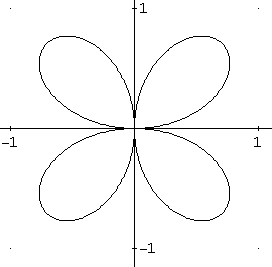 極方程式
極方程式$r=f(\theta)$ が与えれれた時, $x,y$の関係式を求めることも, $x=f(\theta)\cos \theta,y=f(\theta)\sin \theta$ と媒介変数表示することも必要ですが,まず最初にやることは,$\theta$の増加により$r$がどのように変化するかを 調べ,概形を書くことです. 実際 $r=\sin 2\theta$ のグラフを書いてみましょう. なお,曲線 $r=\sin n\theta$ を正葉曲線といいます. $\theta$が$0$から$\frac{\pi}{4}$まで増加するとき,$r$も増加し,$\frac{\pi}{4}$から$\frac{\pi}{2}$まで, 増加するとき$r$は減少します. さらに,$\theta$が$\frac{\pi}{2}$から$\pi$まで増加するときは$r$が負の数ですので,第4象限にグラフが現れます. 原点に関する対称移動を$-\pi$の回転と考えれば第1象限 のグラフを原点の周りに$-\frac{\pi}{2}$回転したグラフになります. $\pi \leqq \theta \leqq 2\pi$も同様に調べることにより,右の図になります. グラフは滑らかですから,グラフ上を鉛筆でなぞれば,第1象限,第4象限,第3象限,第2象限と移動することが 分かるでしょう. 次に $r=|\sin 2\theta|$ を考えましょう. $r \geqq 0$であるから,$\theta$が$0$から$2\pi$まで増加するとき,グラフは 第1象限,第2象限,第3象限,第4象限と順に現れ,第1象限のグラフを原点の周りにそれぞれ $\frac{\pi}{2},\pi,\frac{3\pi}{2}$だけ回転した図形になっています. グラフから分かるように$\theta =\frac{\pi}{2},\pi,\frac{3\pi}{2}$では微分可能ではありません. 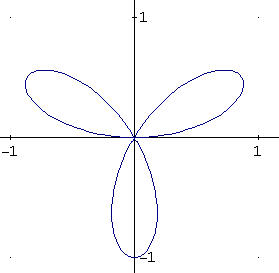 さて,正葉形
さて,正葉形$r=\sin n\theta$ について$n$が偶数と奇数では様子が異なります. ここでは$n$が奇数の場合として $r=\sin 3\theta$ を調べます. 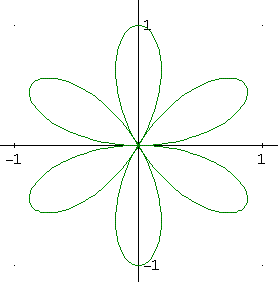 この場合は3つの葉っぱしかありません.
この場合は3つの葉っぱしかありません.$\pi \leqq \theta \leqq 2\pi$のグラフは,$0 \leqq \theta \leqq \pi$のグラフを繰り返します. $f(\theta +\pi)=-f(\theta)$ が成り立つからです. $r=|\sin 3\theta |$ はどうかというと,これは重ならず6つの葉っぱが現れも右図のようになります. このように,極方程式で与えれたとき,すぐに直交座標に直すのではなく,$\theta$の変化で$r$がどうなるかを調べることが 大切です. それでは解答に入りましょう. 解答 曲線 $r(\theta)=|\sin 2\theta|$ のグラフが$x$軸$y$軸,直線$y=x$に関して対称であることを確認する.  $r(-\theta)=r(\theta)$
$r(-\theta)=r(\theta)$より$x$軸に関して対称. $r(\dfrac{\pi}{2}+\theta)=r(\dfrac{\pi}{2}-\theta)$ より$y$軸に関して対称. $r(\dfrac{\pi}{4}+\theta)=r(\dfrac{\pi}{4}-\theta)$ より直線$y=x$に関して対称. したがって,$0 \leqq \theta \leqq \dfrac{\pi}{2}$で調べればより. (1) $x=r\cos \theta =\sin 2\theta \cos \theta$ より, $x'(\theta)=-6\cos \theta (\sin ^2 \theta -\dfrac{1}{3})$ したがって,$\alpha$を$\sin \alpha =\dfrac{1}{\sqrt{3}} \ \ (0\leqq \alpha \leqq \dfrac{\pi}{2})$で定めれば, $\theta =\alpha$で$x$は最大値をとる. そのとき $x=\sin 2\alpha \cos \alpha=\dfrac{4}{3\sqrt{3}}$ $y=\sin 2\alpha \sin \alpha=\dfrac{2\sqrt{2}}{3\sqrt{3}}$ あとは対称性を考えることより, $(x,y)=(\dfrac{4}{3\sqrt{3}},\pm \dfrac{2\sqrt{2}}{3\sqrt{3}})$. (2) $0\leqq \theta \leqq \dfrac{\pi}{2}$のとき, $x=\sin 2\theta \cos \theta ,y=\sin 2\theta \sin \theta $ $\dfrac{\pi}{2} \leqq \theta \leqq \pi$のとき, $x=-\sin 2\theta \cos \theta ,y=-\sin 2\theta \sin \theta $ であるから,$0 \leqq \theta \leqq \pi$で, $\dfrac{dy}{dx}=\dfrac{y'(\theta)}{x'(\theta)}$ が成り立つ. $\dfrac{y'(\theta)}{x'(\theta)}=1$ より $x'(\theta )=y'(\theta)$ $\therefore 2\cos 2\theta \cos \theta -\sin 2\theta \sin \theta =2\cos 2\theta \sin \theta +\sin 2\theta \cos \theta $ 両辺を$\cos 2\theta \cos \theta$で割ると, $\tan 2\theta +2\tan 2\theta+2\tan \theta -2=0$ $\tan 2\theta$を$\tan \theta$で表して整理すると, $\tan ^3 \theta -2\tan ^2 \theta -2\tan \theta +1=0$ $\tan \theta =-1$は解である(グラフより$\theta =\dfrac{3\pi}{2}$が解であることは分かる). $\therefore \tan \theta =-1,\dfrac{3\pm \sqrt{5}}{2}$ (3) $0\leqq \theta \leqq \dfrac{\pi}{2}$で $r=\sin 2\theta$ を最大にする$\theta $は$\theta =\dfrac{\pi}{4}$. $x=\sin 2\theta \cos \theta =x(\dfrac{\pi}{4})$ を解く. $\sin 2\theta \cos \theta =\dfrac{1}{\sqrt{2}}$ $\therefore 4\sin ^3 \theta -4\sin \theta +\sqrt{2}=0$ この方程式は,作りかたより$\theta =\dfrac{\pi}{4}$を解にもつことに注目し, $(2\sin \theta -\sqrt{2})(2\sin ^2 \theta +\sqrt{2}\sin \theta -1)=0$ 第1象限で考えているから,$\sin \theta \geqq 0$より $\sin \theta =\dfrac{\sqrt{2}}{2},\dfrac{\sqrt{10}-\sqrt{2}}{4}$ $\sin \theta =\dfrac{\sqrt{2}}{2}$のとき$\tan \theta =1$ 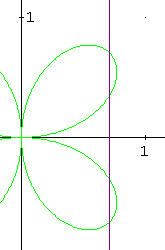 $\sin \theta =\dfrac{\sqrt{10}-\sqrt{2}}{4}$のとき$\tan \theta =\sqrt{\sqrt{5}-2}$.
$\sin \theta =\dfrac{\sqrt{10}-\sqrt{2}}{4}$のとき$\tan \theta =\sqrt{\sqrt{5}-2}$.グラフの対象性より,求める$\tan \theta $の値は, $\tan \theta =1,\pm \sqrt{\sqrt{5}-2}$ (4) (1)でもとめた座標および対称性より,$x$座標が最大,最小である点は $(\pm \dfrac{4}{3\sqrt{3}},\pm \dfrac{2\sqrt{2}}{3\sqrt{3}})$ であり,$y$座標が最大,最小である点は $(\pm \dfrac{2\sqrt{2}}{3\sqrt{3}},\pm \dfrac{4}{3\sqrt{3}})$ である. 次に,曲線 $r=|\sin 2\theta|$ と直線 $x+y=\dfrac{3+\sqrt{3}}{4}$ の交点を求める. 設問(1)から(3)までの問いの答えの中に直線 $x+y=\dfrac{3+\sqrt{3}}{4}$ 上の点があるのかと考えるが,そうではない.交点を新しく求める必要がある. 直線 $x+y=\dfrac{3+\sqrt{3}}{4}$ は極座標に直すと, $r\cos (\theta -\dfrac{\pi}{4})=\dfrac{3+\sqrt{3}}{4\sqrt{2}}$ であるから,$r$を消去すると $\sin 2\theta \cos (\theta -\dfrac{\pi}{4})=\dfrac{3+\sqrt{3}}{4\sqrt{2}}$ である.これを$\sin \theta$や$\cos \theta$の3次式にしても手の施しようがない. $\cos \dfrac{\pi}{12}=\dfrac{\sqrt{3}+1}{2\sqrt{2}}$ であることに注目し, $\theta =\dfrac{\pi}{6}$ が解の1つであることが分かる. 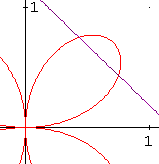 グラフの対称性より,交点は$\theta =\dfrac{\pi}{6},\dfrac{\pi}{3}$のときで,交点の座標は
グラフの対称性より,交点は$\theta =\dfrac{\pi}{6},\dfrac{\pi}{3}$のときで,交点の座標は$A(\dfrac{3}{4},\dfrac{\sqrt{3}}{4}),B(\dfrac{\sqrt{3}}{4},\dfrac{3}{4})$ である. 直線$OA$と曲線で囲まれた図形の面積は $\displaystyle \dfrac{1}{2}\int_0^{\frac{\pi}{6}}r^2d\theta=\dfrac{\pi}{24}-\dfrac{\sqrt{3}}{32}$ $\triangle OAB=\dfrac{3}{16}$ したがって,求める面積は $2(\dfrac{\pi}{24}-\dfrac{\sqrt{3}}{32})+\dfrac{3}{16}=\dfrac{\pi}{12}+\dfrac{3-\sqrt{3}}{16}$ 戻る 目次 全体の目次 |